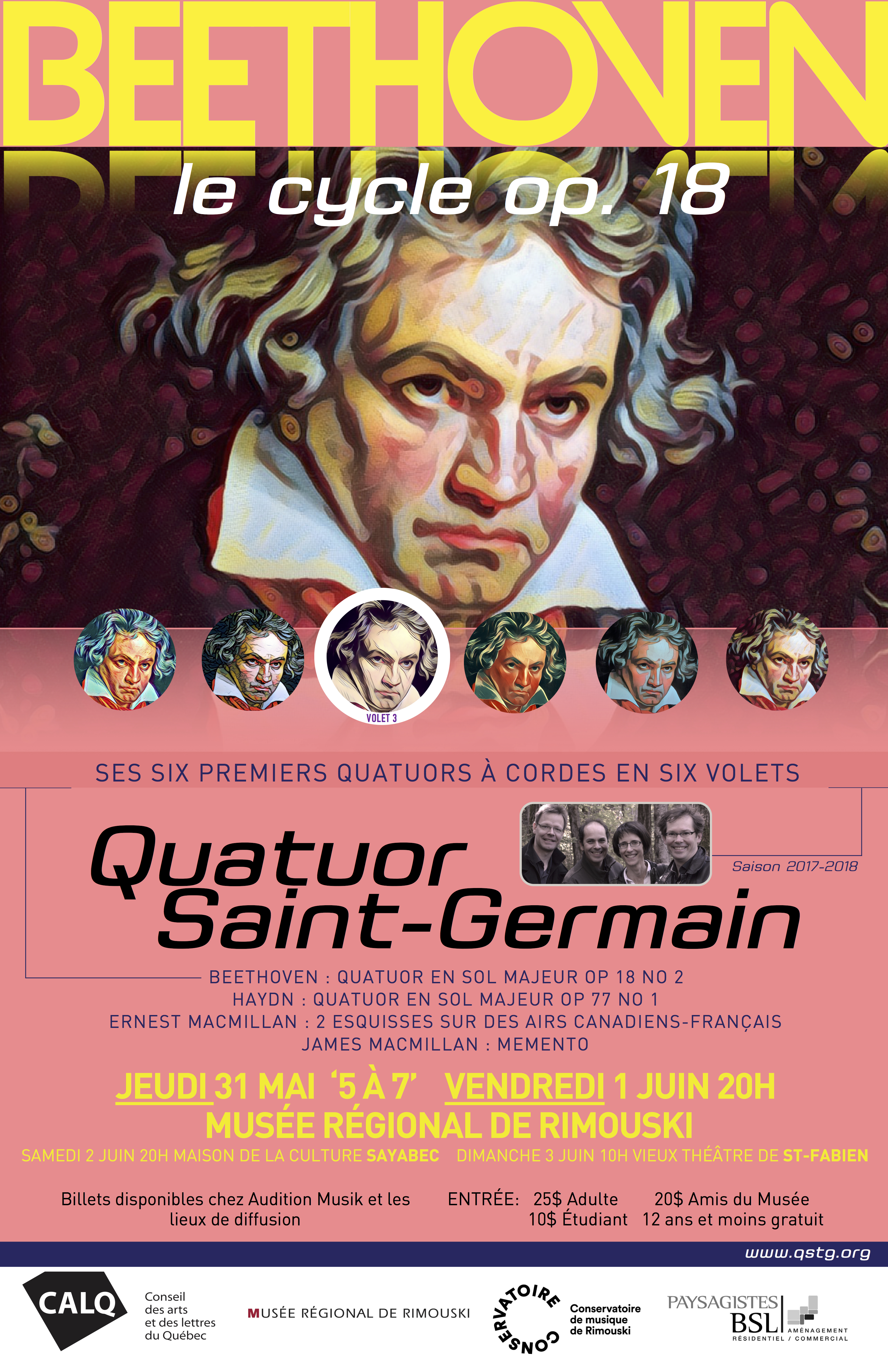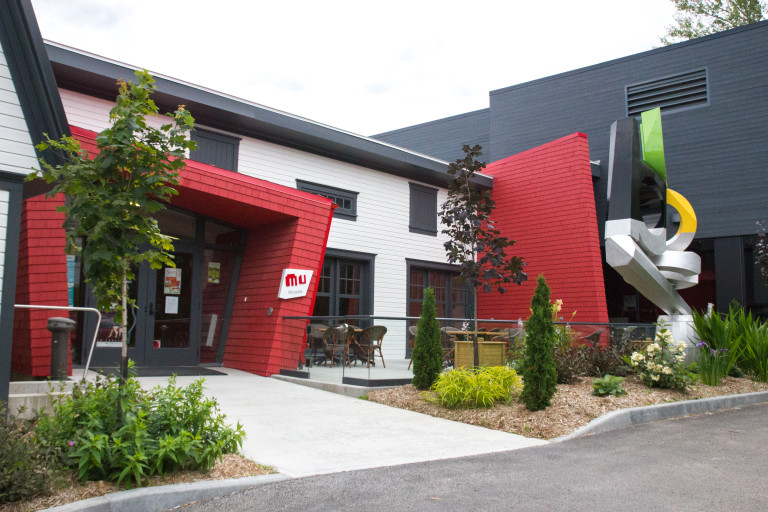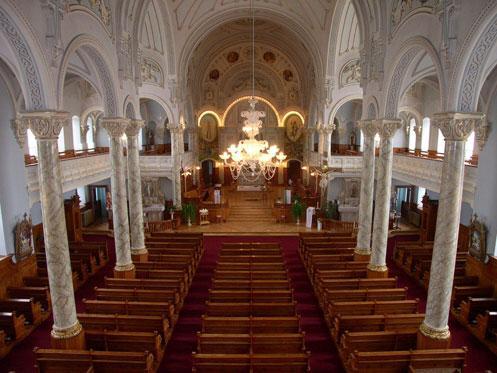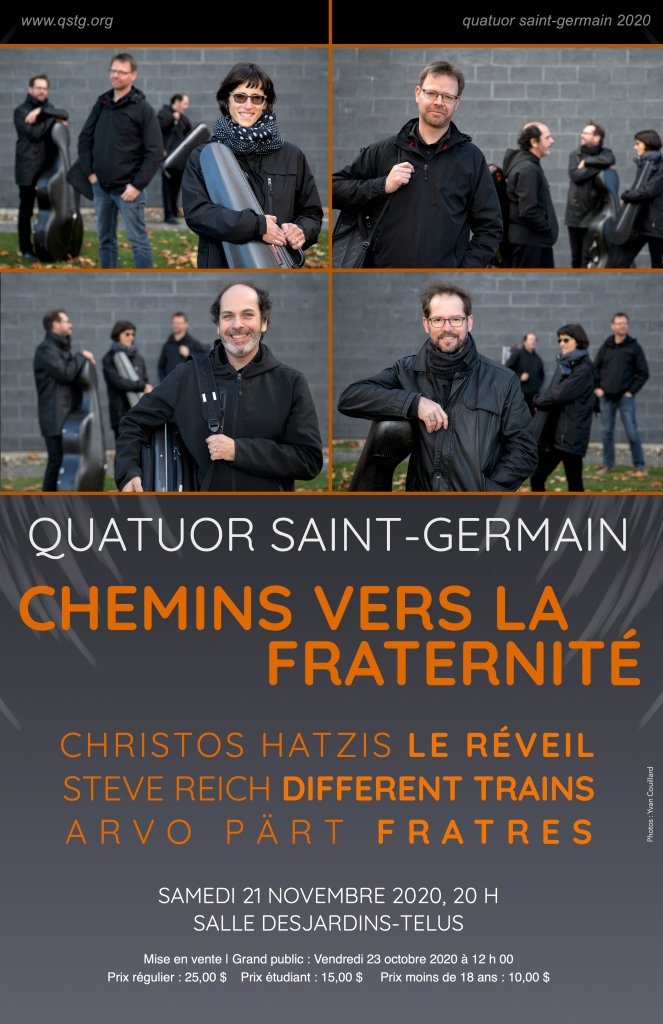
Amazing but true – we are going to play a concert. In front of people. In our hometown.
In fact it’s a big undertaking, technically, musically, emotionally…we’ve entitled our concert (Saturday, November 21 8 pm at the Salle Desjardins-Telus) Chemins vers la Fraternité…I guess Towards togetherness is a close non-gendered translation.
I thought I’d do a post to give you a little to hang on to should you wish to know a little more about the concert, and maybe even entice a few to come who don’t know these works.
It’s been several years that we have wanted to re-program Different Trains of Steve Reich. Amazingly, it’s been already 10 years since the first time we played it in three concerts Rimouski’s Musée régional. For those who know the work, I’m sure you are as taken as I am with the powerful treatment of unspeakable actions ; Reich was struck by the thought of how his own childhood train voyages from coast to coast in North America were so different than those of the trains carrying members of his own family and millions of others to the concentration camps of World War II. With recordings of Holocaust survivors and an evocative soundtrack to which the quartet is synchronized, we are all called to bear witness to the prejudice and cruelty of humankind’s darkest hours.
Here are the notes from a Hollywood Bowl performance of the quartet :
Written for the Kronos Quartet in 1988, Different Trains won the 1989 Grammy for Best Contemporary Composition. Like Vermont Counterpoint, it mixes live performance with pre-recorded material, in this case the voices of Reich’s childhood governess, a retired Pullman porter, Holocaust survivors, and authentic train sounds. “When I was one year old my parents separated,” Reich writes. “My mother moved to Los Angeles and my father stayed in New York. Since they arranged divided custody, I travelled back and forth by train frequently between New York and Los Angeles from 1939 to 1942 accompanied by my governess. While the trips were exciting and romantic at the time I now look back and think that, if I had been in Europe during this period, as a Jew I would have had to ride very different trains.”
The piece is in three movements, played without pause: America – Before the War; Europe – During the War; and After the War. The string players imitate the speech melodies and rhythms, with three separate quartet parts added to the tape.
Here’s a link to a recording :
In this program, we wanted to twin the Reich with another quartet that in a way is also a call to action. The first quartet of Christos Hatzis, a wonderful greco-canadian composer, is sub-titled ‘The Awakening’ : here’s what his editor says about it :
String Quartet No. 1: The Awakening sees the string quartet augmented by the incorporation of an accompanying digital audio part that draws out the inherent musicality of both Inuit throat singing and locomotives. Hatzis samples these sounds in ways that can give the impression of vague memories materialising and then receding, while in other moments they come into sharp focus, the rhythmic nature of these sound sources becoming a driving force alongside the quartet as the piece accumulates momentum and urgency. At other times the quartet’s material is underpinned by synthesizer textures that appear in turn as cavernous low chords, playful twinkling, or mutated simulations of ricochet bowing that extend the timbral palette of the live players. The emotional terrain of the work ranges from poignant to hostile to light-hearted, with these shadings realised through demanding but captivating string writing that employs fluid, microtonal glissandi, forceful tremolo bowing and expressive, mournful melodic lines. After trading statements with the quartet in the work’s energetic climax, the digital audio departs, leaving the unaccompanied players to see out a final extended passage that reprises the work’s sombre thematic material.
Even better, here’s what Hatzis says about his own piece :
String Quartet No. 1: The Awakening was a turning point in my career as a composer. It was composed at a time in my life which could best be described as a crossroads — musical and otherwise. The two most prominent and immediately recognizable references in this work are Inuit throat singers and locomotive engines. The former had been haunting me since 1992, the year I worked on a CBC radio documentary, The Idea of Canada. It was then that I first became exposed to the chanting and vocal games of the native culture of northern Canada, and this work was the first of a number of projects inspired by this culture. The emotional tone of this work was set by the news of an alarming increase in the suicide rate among Inuit youth during the winter of 1994, preceded by the constitutional turmoil two years earlier, when Canadians refused to make their country’s aboriginal people a constitutionally recognized society.
The sound of the locomotive engines had been haunting me since my early childhood. My father was a railway engineer in Volos, my hometown in Greece, at a time when the train was still the primary means of intercity travel. Occasionally my father would take me aboard the locomotive engine of a miniature train for trips up Mount Pelion, the seat of the mythological Centaurs. The “dragon train”, as I used to call it, which was actually transformed into a dragon during carnival, left a strong impression on me. The locomotive’s hungry, fiery mouth, with my father constantly feeding it coal, and the loud sounds it produced, especially the limpid triple beat the of the wheels against the rails, were among the most awesome visual and acoustical images of my childhood.
Eventually, all these sounds – the locomotives, the locomotive-like throat singing and the constant up-bow down-bow articulations of the strings – became a metaphor for primal breathing, Yin and Yang, the endless cycle of creation and destruction which determines the fate of individuals, nations and humanity as a whole.
There are countless references and cross-references in this work that need not be mentioned, except one – the solo cello melody that follows the opening section of the piece. This melody and its ensuing development is a musical affirmation of my faith in the divine and its ability to bring balance, resolution and simplicity in the midst of all the overwhelming complexity we have brought upon ourselves and others.
And a link for a taste of Christos Hatzis :
We finish the program with one of Arvo Pärt’s prayers for peace, Fratres. Why say with many words that which could be expressed by few words…in his austere style, the music of Pärt sounds ancient and modern at the same time. Pärt explained in an interview he gave at some point with the Icelandic pop artist Björk that, in his music, he finds two clear lines: one which symbolizes his sins and, another, their forgiveness. One voice is more complicated and subjective, while the other is simple, clear, and objective. In Fratres, we are compelled to enter into the music, enter into the reflective state encouraged by the repetition and subtle changes of the text. One ebb and flow stretched over 13 minutes. One long moment of introspection and beauty…
Here’s the Kronos playing the Pärt :
Hope to see you there.
QSTG

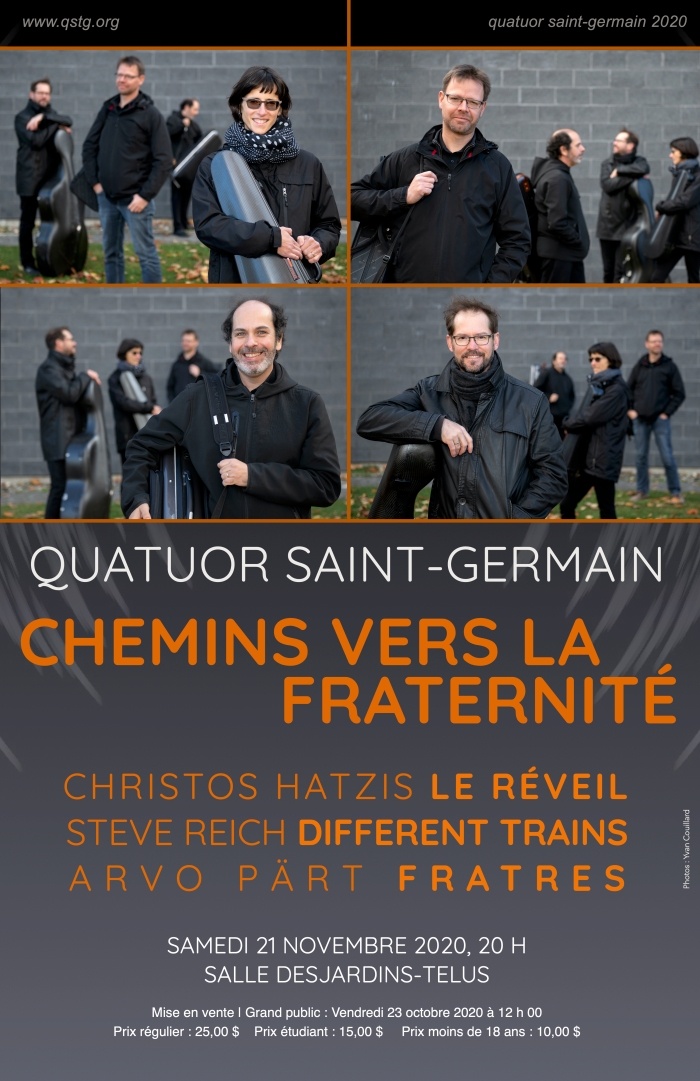
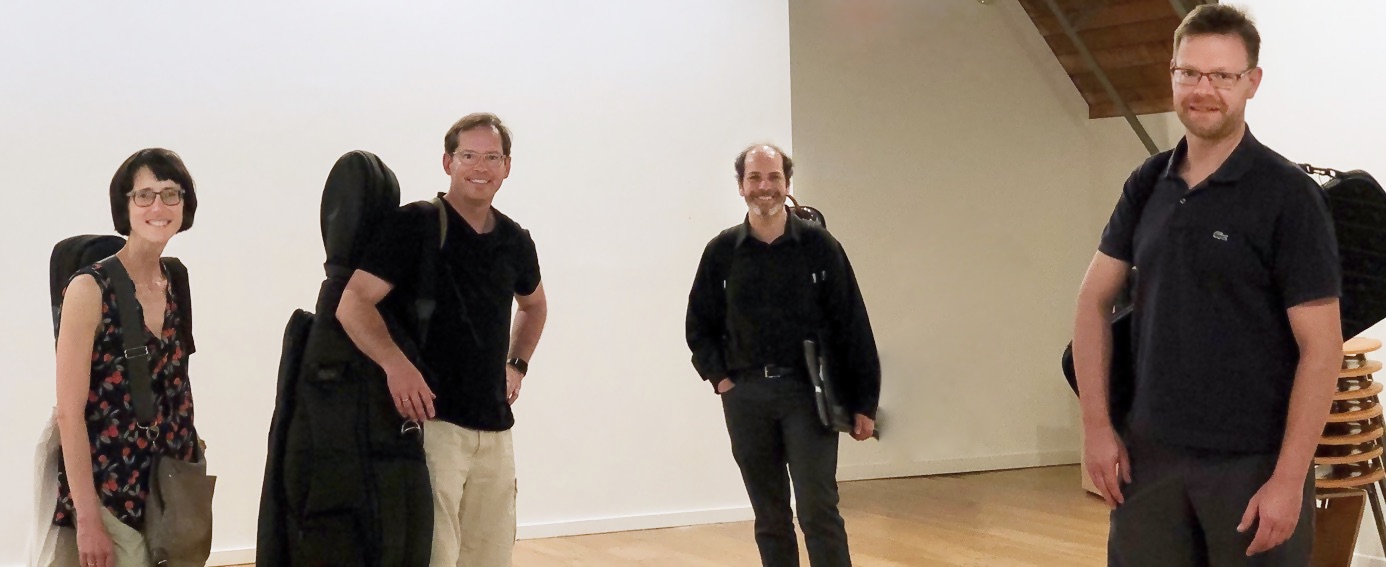 Pour notre plaisir commun, nous vous convions au Ciné-Parc musical jeudi prochain le 25 juin à 21h. Ce concert spécial du quatuor fêtera la réouverture du Musée régional et également la fin de notre 15e saison. On vous offre quelques coups de cœur de nos quinze saisons- du Felix Mendelssohn au Beethoven au Golijov…entre autres. Pour nous, c’est surtout la joie de se revoir en personne, et partager ce bonheur en temps réel avec vous. On vous invite à participer! À jeudi !
Pour notre plaisir commun, nous vous convions au Ciné-Parc musical jeudi prochain le 25 juin à 21h. Ce concert spécial du quatuor fêtera la réouverture du Musée régional et également la fin de notre 15e saison. On vous offre quelques coups de cœur de nos quinze saisons- du Felix Mendelssohn au Beethoven au Golijov…entre autres. Pour nous, c’est surtout la joie de se revoir en personne, et partager ce bonheur en temps réel avec vous. On vous invite à participer! À jeudi !

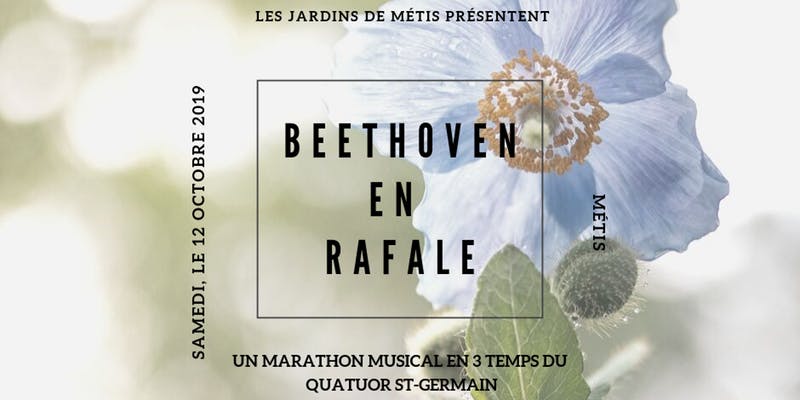

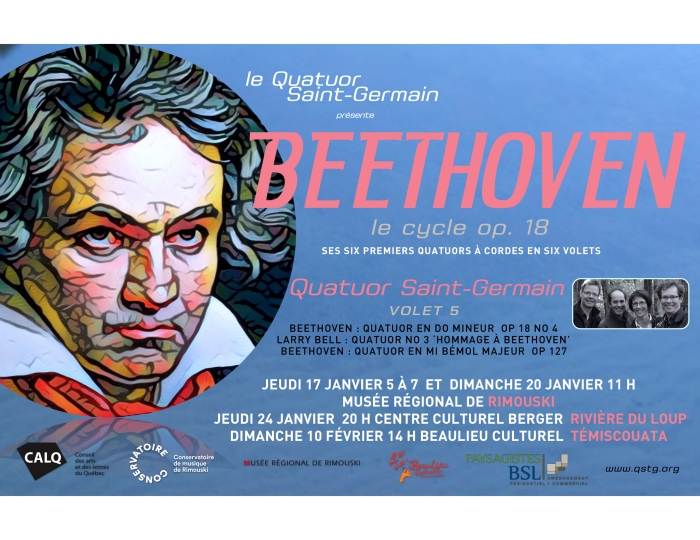
 Nous nous préparons à présenter dans les prochains jours le cinquième volet de notre series des six quatuors op. 18 de Beethoven. Avec le quatuor en do mineur (op. 18 no. 4) nous proposons le monumental et généreux opus 127 en mi-bémol majeur, le premier des quatuors ultimes de Beethoven. En compliment, des extraits du 1e quatuor du compositeur américain Larry Bell qui s’agit d’un hommage au Beethoven, et particulièrement à l’audace qui domine les derniers quatuors.
Nous nous préparons à présenter dans les prochains jours le cinquième volet de notre series des six quatuors op. 18 de Beethoven. Avec le quatuor en do mineur (op. 18 no. 4) nous proposons le monumental et généreux opus 127 en mi-bémol majeur, le premier des quatuors ultimes de Beethoven. En compliment, des extraits du 1e quatuor du compositeur américain Larry Bell qui s’agit d’un hommage au Beethoven, et particulièrement à l’audace qui domine les derniers quatuors.